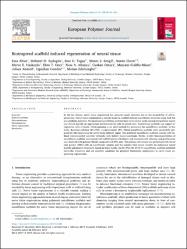| dc.contributor.author | Altun, Esra | |
| dc.contributor.author | Aydoğdu, Mehmet Onur | |
| dc.contributor.author | Toğay, Sine Özmen | |
| dc.contributor.author | Şengil, Ahmet Zeki | |
| dc.contributor.author | Ekren, Nazmi | |
| dc.contributor.author | Erginer Hasköylü, Merve | |
| dc.contributor.author | Toksoy Öner, Ebru | |
| dc.contributor.author | Altuncu, Neşe A. | |
| dc.contributor.author | Öztürk, Gürkan | |
| dc.contributor.author | Crabbe-Mann, Maryam | |
| dc.contributor.author | Ahmed, Jubair | |
| dc.contributor.author | Gündüz, Oğuzhan | |
| dc.contributor.author | Edirisinghe, Mohan | |
| dc.date.accessioned | 10.07.201910:49:13 | |
| dc.date.accessioned | 2019-07-10T19:49:34Z | |
| dc.date.available | 10.07.201910:49:13 | |
| dc.date.available | 2019-07-10T19:49:34Z | |
| dc.date.issued | 2019 | en_US |
| dc.identifier.citation | Altun, E., Aydoğdu, M. O., Toğay, S. Ö., Şengil, A. Z., Ekren, N., Erginer Hasköylü, M. ... Edirisinghe, M. (2019). Bioinspired scaffold induced regeneration of neural tissue. European Polymer Journal, 114, 98-108. https://dx.doi.org/10.1016/j.eurpolymj.2019.02.008 | en_US |
| dc.identifier.issn | 0014-3057 | |
| dc.identifier.issn | 1873-1945 | |
| dc.identifier.uri | https://dx.doi.org/10.1016/j.eurpolymj.2019.02.008 | |
| dc.identifier.uri | https://hdl.handle.net/20.500.12511/1659 | |
| dc.description | WOS: 000467668800012 | en_US |
| dc.description.abstract | In the last decade, nerve tissue engineering has attracted much attention due to the incapability of self-regeneration. Nerve tissue regeneration is mainly based on scaffold induced nanofibrous structures using both bio and synthetic polymers. The produced nanofibrous scaffolds have to be similar to the natural extracellular matrix and should provide an appropriate environment for cells to attach onto. Nanofibrous scaffolds can support or regenerate cells of tissue. Electrospinning is an ideal method for producing the nanofibrous scaffolds. In this study, Bacterial cellulose (BC)/Poly (epsilon-caprolactone) (PCL) blend nanofibrous scaffolds were successfully prepared by electrospinning for nerve tissue induced repair. The produced nanofibrous scaffolds contain well defined interconnected nanofiber networks with hollow micro/nanobeads. Firstly, in-vitro biocompatibilities of nanofibrous scaffolds were tested with L2929 murine fibroblasts and improved cell adhesion and proliferation was observed with polymer blends compared with PCL only. The primary cell culture was performed with dorsal root ganglia (DRG) cells on nanofibrous samples and the samples were found suitable for enhancing neural growth and neurite outgrowth. Based on these results, the BC/PCL (50:50 wt%) nanofibrous scaffolds exhibited nerve-like branching and are excellent candidate for potential biomimetic applications in nerve tissue engineering regeneration. | en_US |
| dc.language.iso | eng | en_US |
| dc.publisher | Pergamon-Elsevier Science Ltd | en_US |
| dc.rights | info:eu-repo/semantics/openAccess | en_US |
| dc.subject | Bacterial Cellulose | en_US |
| dc.subject | Polycaprolactone | en_US |
| dc.subject | Electrospinning | en_US |
| dc.subject | Nerve Regeneration | en_US |
| dc.subject | Biomimetic | en_US |
| dc.title | Bioinspired scaffold induced regeneration of neural tissue | en_US |
| dc.type | article | en_US |
| dc.relation.ispartof | European Polymer Journal | en_US |
| dc.department | İstanbul Medipol Üniversitesi, Tıp Fakültesi, Temel Tıp Bilimleri Bölümü, Tıbbi Mikrobiyoloji Ana Bilim Dalı | en_US |
| dc.department | İstanbul Medipol Üniversitesi, Rektörlük, Rejeneratif ve Restoratif Tıp Araştırmaları Merkezi (REMER) | en_US |
| dc.authorid | 0000-0003-0352-1947 | en_US |
| dc.identifier.volume | 114 | en_US |
| dc.identifier.startpage | 98 | en_US |
| dc.identifier.endpage | 108 | en_US |
| dc.relation.publicationcategory | Makale - Uluslararası Hakemli Dergi - Kurum Öğretim Elemanı | en_US |
| dc.identifier.doi | 10.1016/j.eurpolymj.2019.02.008 | en_US |
| dc.identifier.wosquality | Q1 | en_US |
| dc.identifier.scopusquality | Q1 | en_US |


















